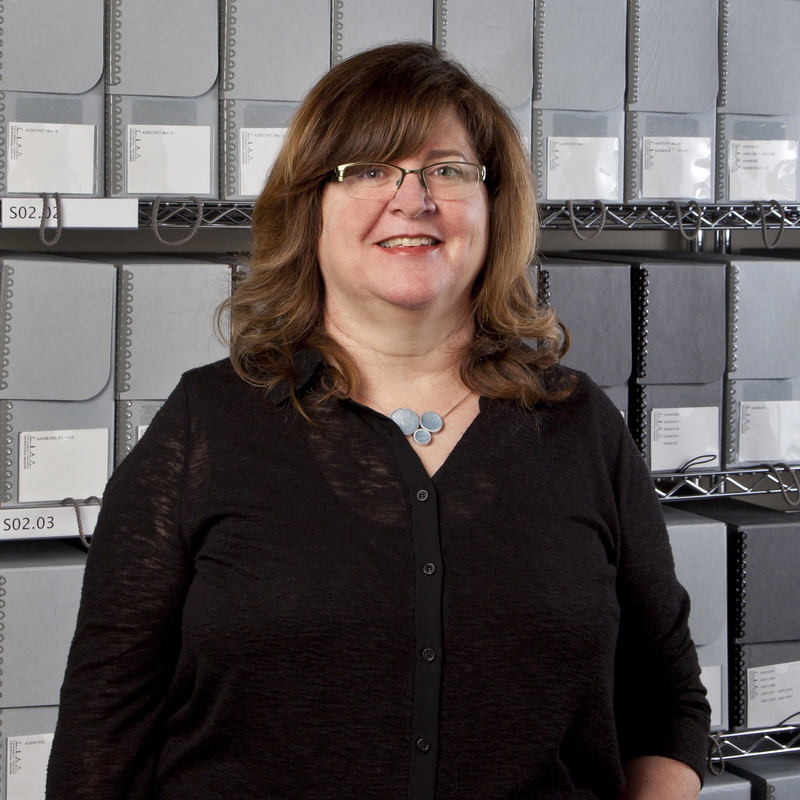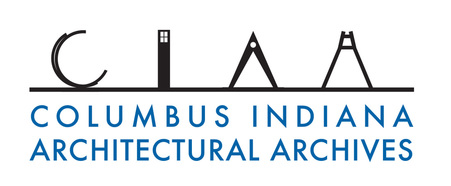detail of Columbus City Hall, Edward Charles Bassett (SOM)
Archivist's Welcome
Much has changed at the Columbus Indiana Architectural Archives since I joined it in 2014. Our recent accomplishments are testament to the community’s support of our mission.
This past year CIAA organized three exhibits and supporting programs. Working with Ball State University, we created “The National Historic Landmarks of Columbus, Indiana” exhibit with funding from the Custer Foundation. The Columbus Area Arts Council, with funding from a Historic Preservation Education grant, sponsored a panel discussion about the exhibit. After the exhibit closed at the Cleo Rogers Memorial Library, it moved to the Bartholomew County Historical Society. At the IU Center for Art + Design, we remounted our 2016 “Developing Downtown” exhibit to coincide with Exhibit Columbus.
With very generous support from the Columbus Area Visitors Center, the Heritage Fund, the Columbus Museum of Art and Design, and the Nugent Foundation, we created our “Avenue of the Architects” exhibit at the Cleo Rogers Memorial Library. The project not only provided historical context for Exhibit Columbus’ Miller Prize installations lining Fifth Street but also highlighted people who presently contribute to our community’s design legacy. These include furniture designer Jonathan Nesci, businesses Noblitt Fabricating and Spectrum Studio, photographers Hadley Fruits and Adam Reynolds, and graphic designer Rick Valicenti.
As our visibility has been raised locally through exhibits, CIAA is becoming recognized nationally and internationally as the primary resource for understanding our community’s design history. More than half the designers who contributed works to Exhibit Columbus’ 2017 Exhibition used CIAA’s collection. Researchers, journalists, and filmmakers consulted the archives both to fact check and to incorporate CIAA’s materials into their publications and films.
Hidden from the public’s eye is work CIAA undertakes to care for our collection. We have concentrated our efforts in two areas: audio-video materials on outdated media as well as fragile drawings and photographs too large to scan. With funding from private donors and the Custer and Nugent Foundations, we have made great headway. In 2018, we will expand our work to include photographing architectural models.
While over the past several years we have worked to increase the visibility of the collection locally, to expand the collection, and to improve the care of the collection for future use, we look to the coming years to make the collection more discoverable and accessible to the public. One step towards this goal has been made possible through an LSTA grant the Bartholomew County Public Library (BCPL) received to digitize materials related to 301 Washington Street and held by BCPL, CIAA, and the Bartholomew County Historical Society. As CIAA’s collection becomes part of the Bartholomew County Public Library, we look forward to continuing to our work to document this community’s extraordinary commitment to good design.
Tricia Gilson, PhD
Archivist
This past year CIAA organized three exhibits and supporting programs. Working with Ball State University, we created “The National Historic Landmarks of Columbus, Indiana” exhibit with funding from the Custer Foundation. The Columbus Area Arts Council, with funding from a Historic Preservation Education grant, sponsored a panel discussion about the exhibit. After the exhibit closed at the Cleo Rogers Memorial Library, it moved to the Bartholomew County Historical Society. At the IU Center for Art + Design, we remounted our 2016 “Developing Downtown” exhibit to coincide with Exhibit Columbus.
With very generous support from the Columbus Area Visitors Center, the Heritage Fund, the Columbus Museum of Art and Design, and the Nugent Foundation, we created our “Avenue of the Architects” exhibit at the Cleo Rogers Memorial Library. The project not only provided historical context for Exhibit Columbus’ Miller Prize installations lining Fifth Street but also highlighted people who presently contribute to our community’s design legacy. These include furniture designer Jonathan Nesci, businesses Noblitt Fabricating and Spectrum Studio, photographers Hadley Fruits and Adam Reynolds, and graphic designer Rick Valicenti.
As our visibility has been raised locally through exhibits, CIAA is becoming recognized nationally and internationally as the primary resource for understanding our community’s design history. More than half the designers who contributed works to Exhibit Columbus’ 2017 Exhibition used CIAA’s collection. Researchers, journalists, and filmmakers consulted the archives both to fact check and to incorporate CIAA’s materials into their publications and films.
Hidden from the public’s eye is work CIAA undertakes to care for our collection. We have concentrated our efforts in two areas: audio-video materials on outdated media as well as fragile drawings and photographs too large to scan. With funding from private donors and the Custer and Nugent Foundations, we have made great headway. In 2018, we will expand our work to include photographing architectural models.
While over the past several years we have worked to increase the visibility of the collection locally, to expand the collection, and to improve the care of the collection for future use, we look to the coming years to make the collection more discoverable and accessible to the public. One step towards this goal has been made possible through an LSTA grant the Bartholomew County Public Library (BCPL) received to digitize materials related to 301 Washington Street and held by BCPL, CIAA, and the Bartholomew County Historical Society. As CIAA’s collection becomes part of the Bartholomew County Public Library, we look forward to continuing to our work to document this community’s extraordinary commitment to good design.
Tricia Gilson, PhD
Archivist
photo by Hadley Fruits

